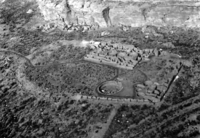
Photo from wikipedia
Abstract We conducted magnetic surveys using an Overhauser magnetometer, a fast-sampling, high-accuracy magnetometer, at two archaeological sites in central Japan to detect magnetic anomalies associated with buried climbing Sue ware… Click to show full abstract
Abstract We conducted magnetic surveys using an Overhauser magnetometer, a fast-sampling, high-accuracy magnetometer, at two archaeological sites in central Japan to detect magnetic anomalies associated with buried climbing Sue ware kilns in suburban hill areas. Our magnetic survey was conducted in two stages, a preliminary sweeping survey followed by a detailed mapping survey. The mapping survey at both sites revealed magnetic anomalies of the order of 10–100 nT that were clearly distinguishable from the low background signals due to the basement rocks and soils. After the magnetic surveys, archaeological excavations were conducted on the basis of these magnetic anomalies, where two kilns were successfully discovered. The shape, dimensions, and magnetization of the kilns are consistent with the amplitude and distribution of the magnetic anomalies. These results highlight that the combination of quick sweeping and detailed mapping magnetic surveys is useful for detecting buried kilns in hillslope areas.
Journal Title: Journal of Archaeological Science: Reports
Year Published: 2018
Link to full text (if available)
Share on Social Media: Sign Up to like & get
recommendations!